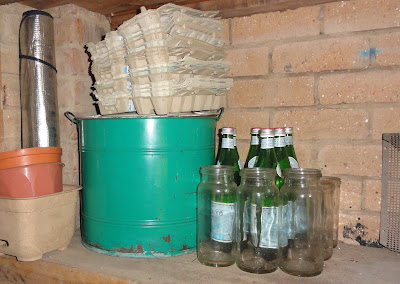Last week, one of the ladies here ask me to show my preserving kit. Here it is in our brick garden shed. I also store excess jars and bottles there, as well as egg cartons that have been given to us. The preserver is a circa 1970s Fowlers Vacola stove-top boiler. I bought it for $20, I think, many years ago. I also have a range of FV jars, lids, rings and clips but I prefer to use screw top jars. I recycle good wide mouthed glass jars and use them several times for jams or relish. You can buy new lids for recycled jars here. The only other tools I use are preserving tongs and a wide mouthed funnel. I bought my preserving tools in a pack of five utensils several years ago but looking online just now I can't find anything like it. You can easily find funnels but you'll also need jar tongs.


If you don't have a preserving kit and want to start preserving a small amount of food, you can use a large stockpot with a round cake stand in the bottom, or, alternatively, a tea towel folded and placed on the bottom of the pan to prevent the jars touching the super hot base. Please be aware that there are several health risks associated with preserving and although the process is a simple one, you need to be aware of the risks as well. You can read some of my previous posts on preserving here, here and here.
Preserving your excess food in a water bath, which is what my preserving kit is, or making jams, pickles chutneys, relish etc, is a very worthwhile skill to learn. If you're new to it, try it first using a stockpot and if you want to get into it in earnest, buy a kit second hand.


I'd like to show you a new addition to my food kittery. My good friend Patrick gave me this wine making kit (above) a few weeks ago. He's decluttering and it was taking up space in his shed. Naturally, I accepted it with open arms. I'd like to make Perry - pear wine, as well as apple cider, elderberry wine and elderflower champagne. I've been looking for a good Perry recipe but many of them recommend Campden tablets, a sulfer tablet, which I don't want to use. Are there any experienced wine or cider makers out there who can tell me an organic alternative?
I'm looking forward to making wine. Not that we drink much of it nowadays, but it's a skill I've always wanted to learn. I'd like to hear from anyone who has already tried it. In the meantime though, I'm starting a ginger beer plant today. I've often made ginger beer in summer in past years. It's a delicious non-alcoholic drink that has that sharp and snappy gingery taste I love. If you'd like to brew along side me, it should take us about two weeks to get our ginger beer ready. We'll be just in time for Christmas day. Every couple of days, I'll show a picture of my ginger beer plant and we'll go through making the ginger beer together. It should be fun.
MAKING GINGER BEER
In a wide mouth jar, start by adding 1 level tablespoon of raw or white sugar to 1 level tablespoon of ginger powder (crushed, dried ginger). Add one cup of rainwater, or tap water that's been allowed to stand for 24 hours to allow the chlorine to evaporate off. Mix this all together and cover the jar with an open weave cotton cover that will allow the wild yeasts in but keep insects out. A crocheted milk jug cover would be perfect. Leave this concoction on the bench to collect wild yeasts and start fermenting. Well, that's our ginger beer started, we'll come back to it on Thursday.


Thank you for all the lovely, warm comments made yesterday and thank you for coming to visit me today. I always look forward to reading what you're up to and making connections with like minded people helps keep me going.
